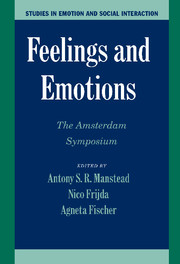Book contents
- Frontmatter
- Contents
- List of Contributors
- 1 Introduction
- PART I THE NATURE OF FEELINGS AND EMOTIONS
- 2 On the Passivity of the Passions
- 3 Emotions and Rationality
- 4 Emotions and Feelings
- 5 The Concept of an Evolved Fear Module and Cognitive Theories of Anxiety
- 6 Deconstructing the Emotions for the Sake of Comparative Research
- 7 From the Emotions of Conversation to the Passions of Fiction
- PART II BASIC PSYCHOLOGICAL PROCESSES IN FEELINGS AND EMOTIONS
- PART III FEELINGS AND EMOTIONS: THE PLACE OF PLEASURE
- PART IV FEELINGS AND EMOTIONS IN THEIR SOCIOCULTURAL CONTEXT
- PART V FEELINGS, EMOTIONS, AND MORALITY
- Subject Index
- Author Index
- Plate section
- References
7 - From the Emotions of Conversation to the Passions of Fiction
Published online by Cambridge University Press: 05 June 2012
- Frontmatter
- Contents
- List of Contributors
- 1 Introduction
- PART I THE NATURE OF FEELINGS AND EMOTIONS
- 2 On the Passivity of the Passions
- 3 Emotions and Rationality
- 4 Emotions and Feelings
- 5 The Concept of an Evolved Fear Module and Cognitive Theories of Anxiety
- 6 Deconstructing the Emotions for the Sake of Comparative Research
- 7 From the Emotions of Conversation to the Passions of Fiction
- PART II BASIC PSYCHOLOGICAL PROCESSES IN FEELINGS AND EMOTIONS
- PART III FEELINGS AND EMOTIONS: THE PLACE OF PLEASURE
- PART IV FEELINGS AND EMOTIONS IN THEIR SOCIOCULTURAL CONTEXT
- PART V FEELINGS, EMOTIONS, AND MORALITY
- Subject Index
- Author Index
- Plate section
- References
Summary
ABSTRACT
In this chapter I argue that narratives provide contexts to make sense of emotions, by linking emotions to the principal aspect of their meaning – namely goals. In literature a character is a person who has goals and who enacts plans to pursue those goals. Narrative plays an integrative role by relating emotions to a narrative line and attributing them to characters. Fiction contributes to the building of characters by means of emotions. Four aspects of story structure are discussed, and it is shown how they elicit emotions in the reader, but also how they enable us to understand emotions.
INTRODUCTION: EMOTION, NARRATIVE, CHARACTER
Grief over the death of a parent, suicidal despair, contempt for women, disgust at sexuality, delight upon seeing a friend, curiosity and dread toward the unexplained – how can we make sense of such emotions? Incidents of this kind are recognizable to emotion researchers. They are what we study. Yet, in this form – raw emotions caused by certain events and directed at certain objects – neither the person who experiences them nor we who read about them could understand their meanings. Something else is necessary.
One necessary aspect is a narrative line. Let me add one and run the sequence again. Hamlet, dressed in black, is asked by his mother why he continues to grieve for his dead father. When she departs, accompanied by her new husband, Hamlet feels suicidal: “Oh that this too too sullied flesh would melt,” he thinks.
- Type
- Chapter
- Information
- Feelings and EmotionsThe Amsterdam Symposium, pp. 98 - 116Publisher: Cambridge University PressPrint publication year: 2004
References
- 14
- Cited by



